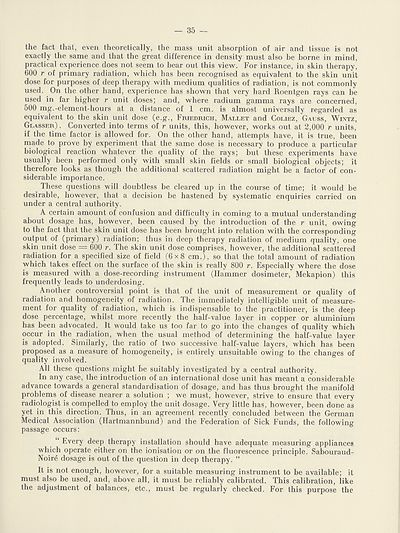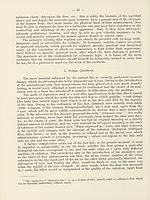Health > Protective measures against dangers resulting from the use of radium, roentgen and ultra-violet rays
(37)
Download files
Complete book:
Individual page:
Thumbnail gallery: Grid view | List view

— 35 —
the fact that, even theoretically, the mass unit absorption of air and tissue is not
exactly the same and that the great difference in density must also be borne in mind,
practical experience does not seem to bear out this view. For instance, in skin therapy,
600 r of primary radiation, which has been recognised as equivalent to the skin unit
dose for purposes of deep therapy with medium qualities of radiation, is not commonly
used. On the other hand, experience has shown that very hard Roentgen rays can be
used in far higher r unit doses; and, where radium gamma rays are concerned,
500 mg.-element-hours at a distance of 1 cm. is almost universally regarded as
equivalent to the skin unit dose (e.g., Friedrich, Mallet and Coliez, Gauss, Wintz,
Glasser). Converted into terms of r units, this, however, works out at 2,000 r units,
if the time factor is allowed for. On the other hand, attempts have, it is true, been
made to prove by experiment that the same dose is necessary to produce a particular
biological reaction whatever the quality of the rays; but these experiments have
usually been performed only with small skin fields or small biological objects; it
therefore looks as though the additional scattered radiation might be a factor of con¬
siderable importance.
These questions will doubtless be cleared up in the course of time; it would be
desirable, however, that a decision be hastened by systematic enquiries carried on
under a central authority.
A certain amount of confusion and difficulty in coming to a mutual understanding
about dosage has, however, been caused by the introduction of the r unit, owing
to the fact that the skin unit dose has been brought into relation with the corresponding
output of (primary) radiation; thus in deep therapy radiation of medium quality, one
skin unit dose = 600 r. The skin unit dose comprises, however, the additional scattered
radiation for a specified size of field (6x8 cm.), so that the total amount of radiation
which takes effect on the surface of the skin is really 800 r. Especially where the dose
is measured with a dose-recording instrument (Hammer dosimeter, Mekapion) this
frequently leads to underdosing.
Another controversial point is that of the unit of measurement or quality of
radiation and homogeneity of radiation. The immediately intelligible unit of measure¬
ment for quality of radiation, which is indispensable to the practitioner, is the deep
dose percentage, whilst more recently the half-value layer in copper or aluminium
has been advocated. It would take us too far to go into the changes of quality which
occur in the radiation, when the usual method of determining the half-value layer
is adopted. Similarly, the ratio of two successive half-value layers, which has been
proposed as a measure of homogeneity, is entirely unsuitable owing to the changes of
quality involved.
All these questions might be suitably investigated by a central authority.
In any case, the introduction of an international dose unit has meant a considerable
advance towards a general standardisation of dosage, and has thus brought the manifold
problems of disease nearer a solution ; we must, however, strive to ensure that every
radiologist is compelled to employ the unit dosage. Very little has, however, been done as
yet in this direction. Thus, in an agreement recently concluded between the German
Medical Association (Hartmannbund) and the Federation of Sick Funds, the following
passage occurs:
“ Every deep therapy installation should have adequate measuring appliances
which operate either on the ionisation or on the fluorescence principle. Sabouraud-
Noire dosage is out of the question in deep therapy. ”
It is not enough, however, for a suitable measuring instrument to be available; it
must also be used, and, above all, it must be reliably calibrated. This calibration, like
the adjustment of balances, etc., must be regularly checked. For this purpose the
the fact that, even theoretically, the mass unit absorption of air and tissue is not
exactly the same and that the great difference in density must also be borne in mind,
practical experience does not seem to bear out this view. For instance, in skin therapy,
600 r of primary radiation, which has been recognised as equivalent to the skin unit
dose for purposes of deep therapy with medium qualities of radiation, is not commonly
used. On the other hand, experience has shown that very hard Roentgen rays can be
used in far higher r unit doses; and, where radium gamma rays are concerned,
500 mg.-element-hours at a distance of 1 cm. is almost universally regarded as
equivalent to the skin unit dose (e.g., Friedrich, Mallet and Coliez, Gauss, Wintz,
Glasser). Converted into terms of r units, this, however, works out at 2,000 r units,
if the time factor is allowed for. On the other hand, attempts have, it is true, been
made to prove by experiment that the same dose is necessary to produce a particular
biological reaction whatever the quality of the rays; but these experiments have
usually been performed only with small skin fields or small biological objects; it
therefore looks as though the additional scattered radiation might be a factor of con¬
siderable importance.
These questions will doubtless be cleared up in the course of time; it would be
desirable, however, that a decision be hastened by systematic enquiries carried on
under a central authority.
A certain amount of confusion and difficulty in coming to a mutual understanding
about dosage has, however, been caused by the introduction of the r unit, owing
to the fact that the skin unit dose has been brought into relation with the corresponding
output of (primary) radiation; thus in deep therapy radiation of medium quality, one
skin unit dose = 600 r. The skin unit dose comprises, however, the additional scattered
radiation for a specified size of field (6x8 cm.), so that the total amount of radiation
which takes effect on the surface of the skin is really 800 r. Especially where the dose
is measured with a dose-recording instrument (Hammer dosimeter, Mekapion) this
frequently leads to underdosing.
Another controversial point is that of the unit of measurement or quality of
radiation and homogeneity of radiation. The immediately intelligible unit of measure¬
ment for quality of radiation, which is indispensable to the practitioner, is the deep
dose percentage, whilst more recently the half-value layer in copper or aluminium
has been advocated. It would take us too far to go into the changes of quality which
occur in the radiation, when the usual method of determining the half-value layer
is adopted. Similarly, the ratio of two successive half-value layers, which has been
proposed as a measure of homogeneity, is entirely unsuitable owing to the changes of
quality involved.
All these questions might be suitably investigated by a central authority.
In any case, the introduction of an international dose unit has meant a considerable
advance towards a general standardisation of dosage, and has thus brought the manifold
problems of disease nearer a solution ; we must, however, strive to ensure that every
radiologist is compelled to employ the unit dosage. Very little has, however, been done as
yet in this direction. Thus, in an agreement recently concluded between the German
Medical Association (Hartmannbund) and the Federation of Sick Funds, the following
passage occurs:
“ Every deep therapy installation should have adequate measuring appliances
which operate either on the ionisation or on the fluorescence principle. Sabouraud-
Noire dosage is out of the question in deep therapy. ”
It is not enough, however, for a suitable measuring instrument to be available; it
must also be used, and, above all, it must be reliably calibrated. This calibration, like
the adjustment of balances, etc., must be regularly checked. For this purpose the
Set display mode to:
![]() Universal Viewer |
Universal Viewer | ![]() Mirador |
Large image | Transcription
Mirador |
Large image | Transcription
Images and transcriptions on this page, including medium image downloads, may be used under the Creative Commons Attribution 4.0 International Licence unless otherwise stated. ![]()
| League of Nations > Health > Protective measures against dangers resulting from the use of radium, roentgen and ultra-violet rays > (37) |
|---|
| Permanent URL | https://digital.nls.uk/191800667 |
|---|
| Shelfmark | LN.III |
|---|---|
| Description | Over 1,200 documents from the non-political organs of the League of Nations that dealt with health, disarmament, economic and financial matters for the duration of the League (1919-1945). Also online are statistical bulletins, essential facts, and an overview of the League by the first Secretary General, Sir Eric Drummond. These items are part of the Official Publications collection at the National Library of Scotland. |
|---|---|
| Additional NLS resources: |
|

